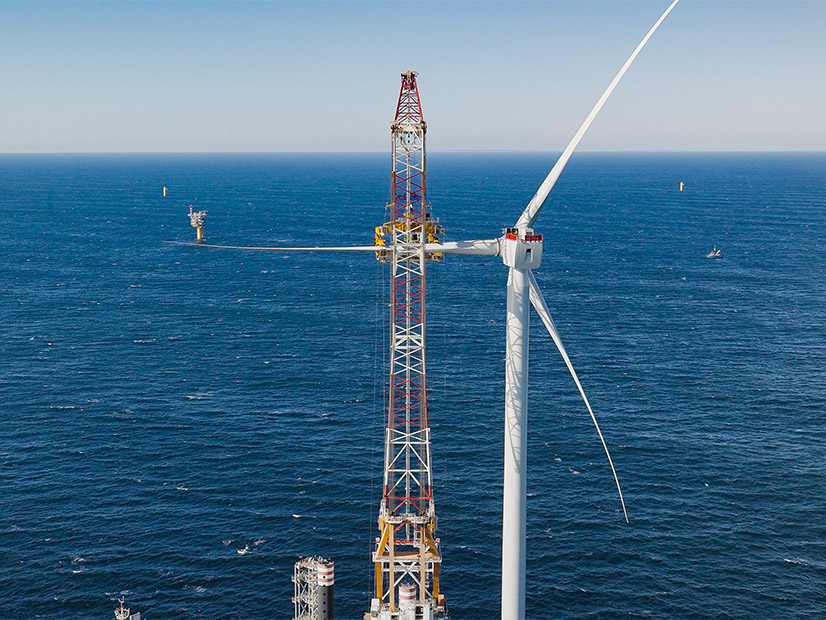The coordinated offshore wind procurements of Connecticut, Massachusetts and Rhode Island received 5,454 MW in bids from four developers, falling short of the 6,000-MW solicitation cap.
The window for bids closed March 27 in the first-of-its-kind coordinated procurement. The states are hoping that joint solicitations will reduce costs by enabling larger-scale projects and better utilizing regional supply chains. Projects could be submitted both as single-state and multistate offers to two or three of the states.
The procurement comes on the heels of a turbulent period for offshore wind in New England. Avangrid Renewables and SouthCoast Wind both backed out of power purchase agreements with Massachusetts in 2023, while Rhode Island Energy canceled the PPA for a joint Eversource- Ørsted project, citing cost concerns.
The bids included multiple recently canceled projects from Avangrid Renewables and SouthCoast, along with new proposals. Avangrid, Ørsted, SouthCoast and Vineyard Offshore all submitted bids for the procurement.
Avangrid
The largest proposal came from Avangrid, which offered an approximately 1,870-MW combined bid of two projects, including its canceled Commonwealth Wind project. The projects, dubbed New England Wind 1 and New England Wind 2, would connect to the grid in Barnstable, Mass.
Avangrid touted the 791-MW New England Wind 1 as a “shovel-ready project” that could reach commercial operations by 2029. It was offered as both a standalone project and a combined proposal with New England Wind 2.
“With nearly all local, state and federal permits in hand, all interconnection rights secured and a project labor agreement signed with a skilled, local, union workforce, Avangrid is ready to go,” CEO Pedro Azagra Blazquez said.
The 1,080-MW New England Wind 2 project, essentially a rebranding of the canceled Commonwealth project, was only offered as part of the combined proposal “to capture important economics of scale and support significant grid upgrades,” the company wrote.
The company also announced memorandums of understanding for power purchases with the city of Boston and the Massachusetts Municipal Wholesale Electric Co. Boston’s MOU will enable it to purchase up to 15 MW of power from New England Wind.
“This partnership advances our climate goals while bringing thousands of green jobs to our region, creating a pathway for generations to come,” said Mayor Michelle Wu.
Vineyard
Vineyard — funded by Copenhagen Infrastructure Partners, Avangrid’s partner on the Vineyard Wind 1 project — proposed a 1,200-MW project dubbed Vineyard Wind 2 to all three states. The project would be south of Nantucket, reaching the shore in New London, Conn., and connecting to the grid in Montville.
“By making effective use of ports, facilities and interconnection points throughout the region, Vineyard Wind 2 offers the most economic project configuration possible while delivering economic benefits for all three states,” said CEO Alicia Barton.
The company also highlighted a recently signed tribal benefit agreement with the Mashpee Wampanoag Tribe for the proposal. According to the bid, the agreement would create a fund to “support education, environmental and natural resources, cultural resources and historic preservation efforts by the tribe.”
SouthCoast
Following the cancellation of its PPA in 2023, SouthCoast resubmitted a 1,200-MW proposal to the states for the coordinated solicitation. The company said it could begin construction in 2025 and reach commercial operations by 2030.
“The punishing inflation of 2020-2023 profoundly impacted infrastructure costs, upending the economics of projects that had fixed revenues but still needed to fix their costs,” the company wrote. “The clear lesson is that a quick turn from award to construction is critical to de-risk a macroeconomic environment that no one can control.”
The project has “crucial manufacturing slots and supply chain reservations secured and [a] federal permit Record of Decision expected this year,” the bid noted.
Ørsted
Ørsted submitted standalone and multistate bids in Rhode Island and Connecticut for its 1,184-MW Starboard Wind project.
Ørsted and Eversource are constructing Revolution Wind, a 704-MW project that will provide power to Rhode Island and Connecticut. Ørsted and Eversource’s bid for Revolution Wind 2, a proposed 884-MW project, was rejected by Rhode Island Energy in 2023.
“While the project name Starboard Wind is new, our work on the project itself is not,” Ørsted wrote. “We’ve been developing the offshore project site for nearly a decade, giving us extensive site data and a deep understanding of how to construct our proposed offshore wind farm successfully.”
The three states now have until Aug. 7 to evaluate and make decisions on the bids.
“The Healey-Driscoll Administration will review bids over the coming months and coordinate with Connecticut and Rhode Island to evaluate multistate projects that would increase benefits for the region,” said Elizabeth Mahony, commissioner of the Massachusetts Department of Energy Resources. “Massachusetts is committed to growing its offshore wind industry, which will spur our clean energy transition and provide renewable, affordable power to our homes and businesses.”


